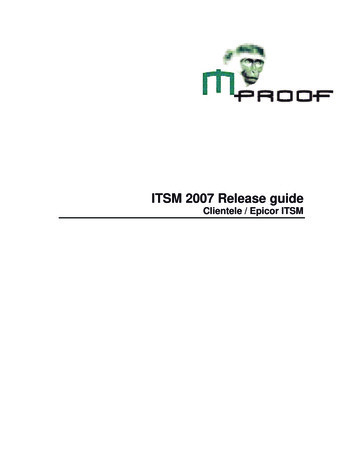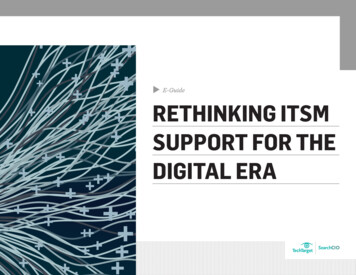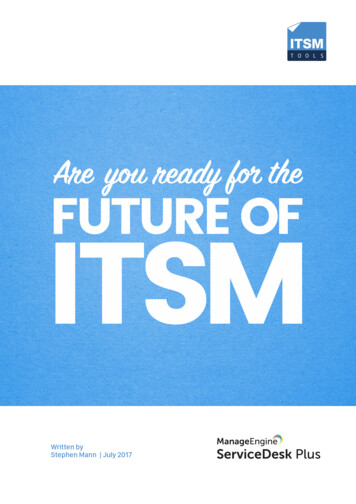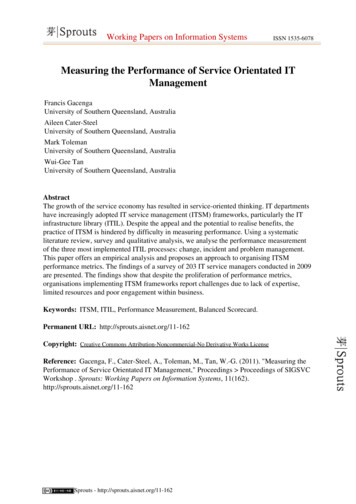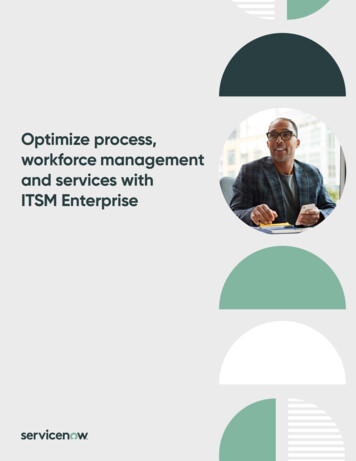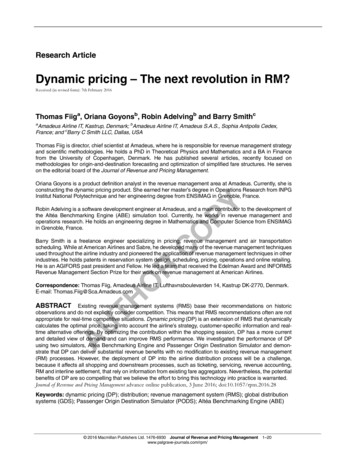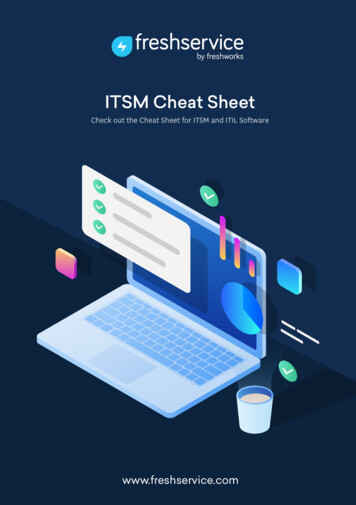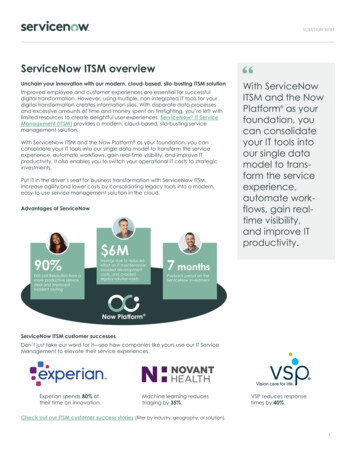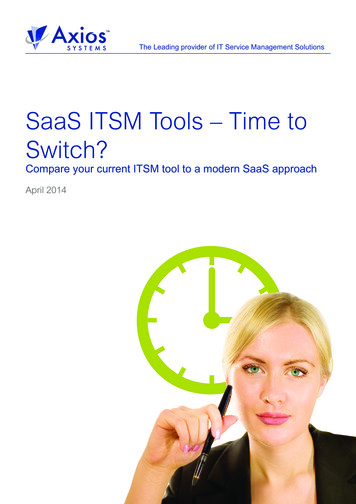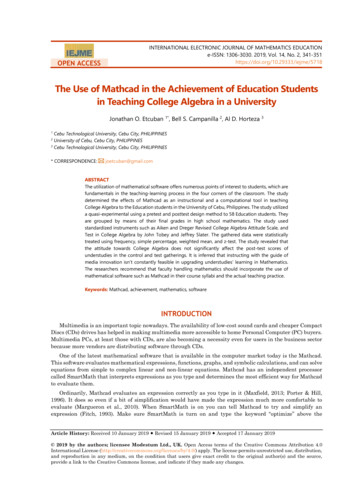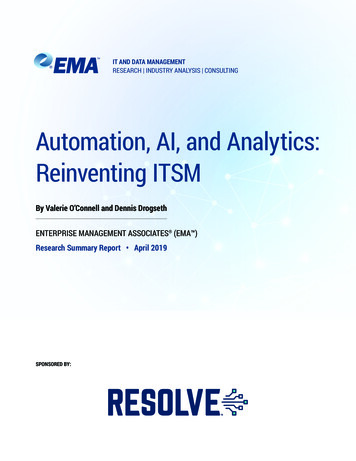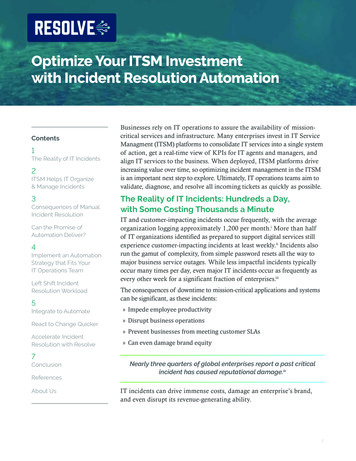
Transcription
Optimize Your ITSM Investmentwith Incident Resolution AutomationContents1The Reality of IT Incidents2ITSM Helps IT Organize& Manage Incidents3Consequences of ManualIncident ResolutionCan the Promise ofAutomation Deliver?4Implement an AutomationStrategy that Fits YourIT Operations TeamLeft Shift IncidentResolution Workload5Businesses rely on IT operations to assure the availability of missioncritical services and infrastructure. Many enterprises invest in IT ServiceManagment (ITSM) platforms to consolidate IT services into a single systemof action, get a real-time view of KPIs for IT agents and managers, andalign IT services to the business. When deployed, ITSM platforms driveincreasing value over time, so optimizing incident management in the ITSMis an important next step to explore. Ultimately, IT operations teams aim tovalidate, diagnose, and resolve all incoming tickets as quickly as possible.The Reality of IT Incidents: Hundreds a Day,with Some Costing Thousands a MinuteIT and customer-impacting incidents occur frequently, with the averageorganization logging approximately 1,200 per month.i More than halfof IT organizations identified as prepared to support digital services stillexperience customer-impacting incidents at least weekly.ii Incidents alsorun the gamut of complexity, from simple password resets all the way tomajor business service outages. While less impactful incidents typicallyoccur many times per day, even major IT incidents occur as frequently asevery other week for a significant fraction of enterprises.iiiThe consequences of downtime to mission-critical applications and systemscan be significant, as these incidents:Integrate to Automate» Impede employee productivityReact to Change Quicker» Disrupt business operationsAccelerate IncidentResolution with Resolve» Prevent businesses from meeting customer SLAs» Can even damage brand equity7ConclusionReferencesAbout UsNearly three quarters of global enterprises report a past criticalincident has caused reputational damage.ivIT incidents can drive immense costs, damage an enterprise’s brand,and even disrupt its revenue-generating ability.1
In concrete terms beyond brand equity, almost one in three enterprises reports one hour of IT downtimecosts 1 million or more, with an average cost of downtime of 8,662 per minute.v Close to 80% of thecost of downtime is attributed to loss of employee productivity, with the sales organization being the mostfrequently impacted.viWhat Standard IncidentManagement Tools ProvideKPIsDashboardIncident DeflectionDisruptionsEscalationsHigh CostSwivel ChairSlow lutionProblemsBrand DamageCustomer DissatisfactionSLA ViolationsHuman ErrorITSM Helps IT Organizeand Manage IncidentsITSM platforms help by offering a quality toolkit for: deflectingincidents via a service portal; capturing IT incidents acrossmultiple contact channels; viewing incidents in the broadercontext of all IT tasks and projects; tracking incident workstatus; organizing a variety of service-level commitmentsbetween providers and customers; and (in some cases) on-callscheduling. In essence, ITSM circles an IT incident, connectsthe team, tracks, and reports to drive better performance for thewhole IT operations organization.At first glance it appears the enterprise’s incident managementneeds are fully addressed by an ITSM. However, consider theactual resolution of the incident. Enterprises aim not just to trackand report on incidents, but also resolve them faster, more reliably,and cheaply. And not just for the day-to-day incidents, but alsofor the most complex and potentially disruptive incidents as well.Incident Resolution Is Too Critical forManual MethodsIT incidents are commonly resolved manually. This approach is slow and has many dependencies. When tryingto validate, diagnose, or resolve an incident, frontline agents often must “swivel chair” between the ITSMand other siloed systems. The results of their commands are sometimes difficult to understand and activitydata can be lost in the transfer between tools. What’s more, frontline agents typically lack permissions to loginto impacted systems or execute necessary diagnostic and remediation actions. This causes unnecessaryescalations to Level 2 and beyond, even for relatively simple incident types, so more incidents end up waitingfor attention from fewer people.Manual incident resolution also invites human error. Many IT organizations lack complete or up-to-datestandard procedures for frontline agents to validate, diagnose, and resolve incidents. Even if they are able tointerpret command results, their best judgment is their only guide.Best judgment is also relied upon in documenting results and stepstaken in the ITSM ticket while addressing an incident. As frontlineagents are the least experienced members of an IT organization, theirbest judgment is unlikely to deliver the high quality or consistencyneeded for robust incident resolution.IT incidents are commonlyresolved manually in theenterprise today.2
Consequences: Higher OpEx, Missed Opportunities,and Potential Reputational DamageAll these escalations bring heavy burdens to the IT organization, the most glaring of which is an increasedoperations expense. When a Level 2 agent or Subject Matter Expert (SME) (e.g., database administrator,network engineer, systems engineer, security professional, etc.) receives an escalation, he must spend timereviewing the ticket and replicating the actions of the frontline agent before he can continue to drive theincident forward. There is a high cost to this individual’s time. Incidents resolved by Level 2 agents cost theorganization nearly three times as much as those resolved by frontline agents. Incidents resolved by top-tierIT resources cost a whopping nine times what a frontline agent-resolved incident does.viiBeyond calculable operations cost, escalated incidents also carry significant opportunity cost for theIT organization. Some 60% of organizations say incidents and outages cause IT team disruptionand distraction.viii Escalations reduce the productivity of Level 2 agents and SMEs, as these valuablepersonnel spend time on reactive, incident-related fire-fights rather than value-added projects to fosterthe broader enterprise. In extreme examples, this effect may even compromise the pace of innovation.The consequences of slow incident resolution are felt across the business. The longer a major incidenttakes to resolve:» The longer and more serious the service impact» The more likely customer SLAs are to be violated» The higher the chances a customer-impacting incident will negatively affect brand equityIn the case of major incidents, IT organizations take half an hour on average just to assemble the rightmembers into an IT response team, and the average time to resolve major incidents is nearly six businesshours, with the most severe extending well beyond that.ixCan the Promise of Automation Deliver?Clearly, incident resolution is a valuable area to focus improvements that will reduce expensivemanual efforts, errors, and escalations. By promptly identifying service issues and quickly validating,diagnosing, and resolving IT incidents, businesses can drastically reduce legal and financial pitfalls;improve customer satisfaction; and mitigate other risks associated with infrastructure or service failures.This is why many IT operations teams are investigating the promise of automation, as well-appliedautomation can help the organization manage increasing numbers of systems and users withoutadding costly head count. The key question on many IT operations leaders’ minds is:How do you approach automation for incident resolution?Getting to the answer requires understanding the types of automation availableas well as when and how to implement them.Faster, Consistent Incident Resolution with AutomationIn pursuit of improved IT incident resolution, many focus exclusively on introducing automation as awholesale replacement for human activity. This is often referred to as “end-to-end” automation—whereautomation handles an incident without any human involvement all the way from validation throughdiagnosis to resolution. Although end-to-end automation can help remove human error and speed upresolution for certain types of incidents, IT needs to accelerate all incidents, including the complex ones.This means other key capabilities are required alongside end-to-end automation for maximum acceleration.3
Implement an Automation Strategy that Fits Your IT Operations TeamAs discussed, IT incidents span a spectrum of complexity, from simpleEnd-to-End Automation:service requests, like creating a user account, to critical businessAutomation that handlesservice outages that may involve multiple layers of applications andan incident without anyinfrastructure. This means that IT operations needs a strategy tohuman involvement,accelerate all incident types, from the simple (server restart, passwordfrom validation throughreset) all the way to the most complex (virtual infrastructure, customerdiagnosis to resolution.portal) incidents. For simple incidents, end-to-end automation canaccomplish the entire resolution process with no human interaction.However, challenging incidents affecting mission-critical systems can’t easily be addressed by end-toend automation. In these cases, IT teams should employ automation to work with the human agent toisolate and validate the problem area across a broad technology stack. Complex incidents and incidentsaffecting mission-critical systems can’t be addressed by end-to-end automation.What would this optimal strategy look like in practice? An effective method would be to provide agentsinteractive procedures containing targeted automations to help execute incident validation, diagnosis,and resolution. An “interactive” procedure is one that helps an agent troubleshoot and investigate acomplex incident by asking questions and updating itself in response to the agent’s answers. That way,the agent can effectively direct the incident down the right path to a quicker resolution.Targeted automation is the opposite of end-to-end automation, as a targeted automation takes care of asingle task in the midst of an agent’s larger workflow to save the agent from slow, manual tedium.The combination of these two capabilities means any previously-manual process can be modelledand accelerated.Interactive Procedure: A procedure that updates in response to an agent’s choices.Targeted Automation: Automation that performs a single task in the midst of a larger,human-directed workflow.Left Shift the Incident Resolution WorkloadAs escalations are harmful to both the IT organization and the broaderenterprise, IT operations should seek to reduce escalations (often referred to as“left shifting” work) to achieve the fastest incident resolution at the lowest cost.Automation can assist in this aim by proactively testing systems to identifyand remediate issues before they have a business impact.With such a platform in place, the IT organization will see a reduction inescalations and increased team morale.Left Shift:Push work to thelowest-tier resourceavailable; i.e., fromL2 to L1, and fromL1 to automation.Integrate to AutomateAutomation does not occur in a vacuum. IT operations teams need an incident resolution automationplatform that can readily interoperate with their existing IT systems and infrastructure. Resolution actionswill likely include making controlled changes to connected assets and systems to fix identified problemsand may require the platform to stitch together data from multiple IT management applications, theCMDB, network topology, and other tools to help with both human and automated decision making.4
React to Change Quicker with High MaintainabilityAs obsolete procedures or automations can harm the qualityof incident resolution, IT operations should be able to respondquickly to changes in infrastructure, applications, and businessprocess services. This means an incident resolution automationplatform should enable rapid deployment of new automationsand changes to existing automations.Non-developer IT operationsexperts need tools to quicklybuild and edit automations.Development of new automated processes accelerates with a library of pre-built automations, buildingblocks, and connections to 3rd-party systems. As every organization’s environment is unique, nondeveloper IT operations SMEs should be enabled to quickly build and edit automations. This enablement notonly saves IT operations from having to wait on support from an external development team, it’s alsoa way of retaining and implementing IT experts’ tribal knowledge.Accelerate Incident Resolution with ResolveThese key capabilities can be brought to IT operations’ ITSM with Resolve.Resolve is an industry-leading software platform for resolving IT incidents at scale and withlowest cost and mean time to resolution.Resolve accomplishes this by fully automating the validation, diagnosis, and resolution of incidentswherever possible. When human intervention is required, Resolve provides frontline agents interactive,context-specific procedures and embedded automations to reduce escalations to Level 2 agents orexpensive SMEs.The largest global enterprises have deployed Resolve, as the platform stands up to the most demandingrequirements of performance and scale. Resolve provides an integrated experience to help extendorganizations’ investments in ITSM.To achieve quick time to value and quick time to market with new or edited automations, Resolveoffers an extensive library of pre-built automations and procedures for known incident types and outof-the-box integrations to key IT systems. It also offers a low-code automation builder and graphicaldevelopment tools for building automations and interactive guidance. Resolve even supports SaaS, onpremise, and hybrid installation methods.ConclusionAs incidents continue to pile up on IT operations teams and cost organizations huge sums of money,ITSMs step in to help IT organize and manage the onslaught of incidents. IT leaders seek to resolveincidents faster and more efficiently, and automation is key to this initiative. Achieving success withincident resolution automation hinges on having a comprehensive automation strategy that left-shiftsworkload, along with an eye to integrating automation into the infrastructure and ensuring highmaintainability.Resolve compliments ITSMs in these crucial areas and speeds responses to even the most complex ITincidents, helping IT operations teams maintain critical service continuity and reduce operations costs.5
ter and in-it-operations and e-of-incident-management/9.Ibid and ntrol-the-impact-of-critical-it-incidents.pdfAbout Resolve SystemsResolve Systems is the global leader in providing a single platform for enterprise-wide incident response,automation and process orchestration for Security Operations, IT Operations, Network Operations andservice desk teams.Resolve accelerates incident response and resolution by supplying engineers with partially or fullycustomized human-guided automations, powerful real-time incident collaboration and the omnipresence toorchestrate existing systems, across silos.Headquartered in Irvine, California, USA with operations in EMEA and APAC, Resolve Systems workswith nearly 100 of the largest global firms and is majority owned by funds affiliated with Insight VenturePartners, a leading global private equity and venture capital firm investing in high-growth technologyand software companies.About Insight Venture PartnersInsight Venture Partners is a leading global venture capital and private equity firm investing in high-growthtechnology and software companies that are driving transformative change in their industries. Foundedin 1995, Insight has raised more than 13 billion and invested in nearly 300 companies worldwide. Ourmission is to find, fund and work successfully with visionary executives, providing them with practical,hands-on growth expertise to foster long-term success.For more information on Insight and all of its investments, visit www.insightpartners.com or followus on Twitter.resolve.ioNorth American Headquarters2302 Martin StreetSuite 225Irvine, CA 92612T: 1.949.325.0120EMEA Headquarters60 Cannon StSuite 119London EC4N 6LY, UKT: 44 (20) 37432123Asia Pacific Headquarters1 Fullerton Road#02-01, One FullertonSingapore 049213T: 65 6832 55136
Managment (ITSM) platforms to consolidate IT services into a single system of action, get a real-time view of KPIs for IT agents and managers, and align IT services to the business. When deployed, ITSM platforms drive increasing value over time, so optimizing incident management in the ITSM is an important next step to explore.
